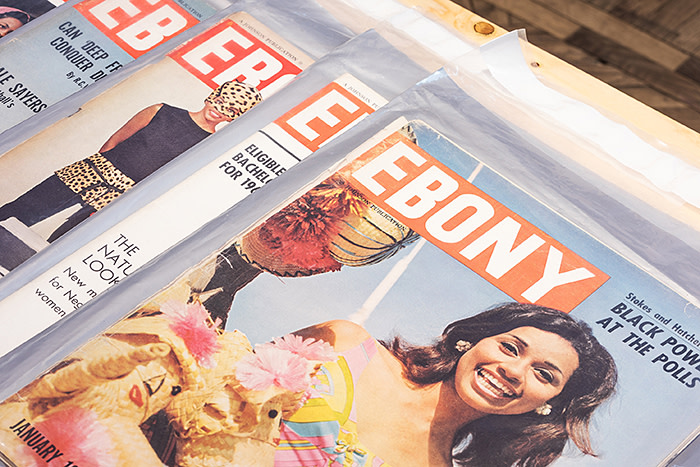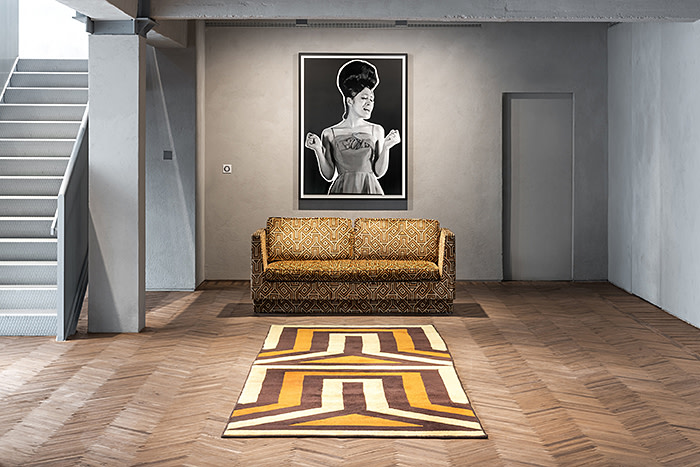Encounter with another truth

Simply sign up to the Life & Arts myFT Digest -- delivered directly to your inbox.
The splendid, glass-vaulted space of the Vittorio Emanuele gallery, built in Milan in 1865, has a justifiable claim to be considered the world’s first shopping mall. An unashamed temple of high-end consumerism, it is now also playing host to a bold and disorientating exhibition.
The Black Image Corporation, conceived by the American artist Theaster Gates, is a small exhibition of portraits of black women in fashion shoots from the postwar years. They have been reclaimed by Gates from the archive of the Johnson Publishing Company, which brought out Ebony and Jet, two of the most influential magazines of the period aimed at black consumers.
The show is commissioned by the Prada Foundation, and housed in the luxury fashion house’s Osservatorio gallery, which stands opposite its flagship store under the gallery’s spectacular octagonal roof. Gates is known as a community artist, whose radical linking of artistic practice and urban redevelopment in poverty-stricken districts of his home city of Chicago has made him one of the most iconoclastic, and intellectually supple, figures in the contemporary art world.
There is maybe something of an irony at play here, I suggest to him. “Yeah!” he exclaims with relish, predictably embracing the issue head-on. He traces the exhibition’s beginnings to his meeting with Linda Johnson Rice, whose father founded the Johnson Publishing company, where her mother was an executive. Gates remarks: “She [Johnson Rice] said to me: ‘The most important thing for me is that people remember my mother and father’s legacy.’ She didn’t say, the most important thing was for 10m people to see the images.

“Eunice Johnson [Linda’s mother] was probably buying Prada, or if Prada wasn’t known, she was buying other Italian fashion houses. I knew that Linda would love to see all those things that came out of the Johnson company, connected to something like this. When I was trying to figure out what to do an exhibition about, it just felt right that I would align the fashion house of black America with the fashion house of Italy.
“And that context-making felt like poetry. It wasn’t about putting these images in a poor black immigrant community. In fact, I want black immigrants living in Milan to come to the most fancy places, and put on their fancy clothes, and feel like they have something in common with these sisters on the wall! That’s sexy!” Gates speaks quickly and fluently, in a tone which is both measured and impassioned.
The show is not just about the images, however. As is always the case in Gates’s work, there is a deeper concern here: a championing of the entrepreneurial dynamism of the company that became, as he writes in the show’s catalogue, “a clearing house of Black intelligence, creativity and consciousness”.
These images of normalcy on the walls, I say to him, came at a time when most images of black Americans were connected with struggle, strife and violence. He bends down dramatically as I pronounce each of those words.
“This exhibition gives people an intimate encounter with another truth,” he says as he pops back up. “That there were fine, hard-working black men and women in this moment when we thought the only good thing in fashion was Vidal Sassoon!”

The Black Image Corporation is related to a larger body of Gates’s work, the “Black Madonna” series, which was on show at Basel’s Kunstmuseum this year. He describes it as “a chance to deeply consider the black woman, as a black man, and reflect on the great women in my life, and offer this as a tribute to [them]”.
Yet he emphasises that the actual images on display are not his primary concern; his focus is more transcendental. It is the very process of researching the archive, bringing it back into public attention, displaying it with “dignity”, that constitutes the art work.
“I am not interested in recycling things,” he says. “That’s other people’s language. I’m interested in the spirit that’s inside things. The energy. And I’m especially interested in things when people think there is no longer any energy in them. But one has to understand how to wake that spirit up.”
An awakening of the entrepreneurial spirit, not a common concern of art, lies at the heart of Gates’s work in Chicago. He came to prominence, following an education in ceramics, religion and urban planning, when he began to revitalise property in the city for community and cultural use, financing the project by selling art works made from the scrap of earlier renovations. His success — cities worldwide seek his advice on urban regeneration — earned him the label of the “real estate artist”.
He gives what might be considered a mission statement in stark terms: “Rather than make a painting about the struggle of black people and the lack of social opportunities, why not try to create social and cultural opportunities?

“I’ll be honest,” he says. “Most of the things that I do don’t make money.” He explains that what he feels good about is his respect for what he calls a “Shintoistic” view of the world (Gates spent part of his education studying pottery in Japan). It has evidently served him well. “Where a western mind wants to cut a tree down because it wants to build a house,” he says, “an eastern mind will recognise that the tree has spirit in it, and that spirit will nurture whatever there is around it.”
I ask him about the continuing presence of racially motivated strife in the US, at a time when black culture is making such inroads into mainstream culture. “A liberal world is ready to essentialise the best of people,” he replies. “Even though it seems there is more of a black audacious presence, that audacious presence is coming out of a refusal of black bodies. You essentialise Kendrick Lamar, Jennifer Hudson. You essentialise Aretha Franklin, Cornel West. So you think, man, the president of the fucking United States! Things must be getting better!
“I want to get to a point where you don’t have to be great to be on the list. I have to be the baddest fucking artist in the world to be invited to some dinners. If I’m not that . . . You know, everyday HoJo white people that are at things, it’s like, ‘How did you get here?’, ‘Oh, I’m just the janitor of the family.’ ‘Oh, I’m just a schoolteacher.’” He lowers his voice. “Ain’t no black schoolteachers here.
“I don’t know that black genius is any more genius. But maybe the barriers to entry are just a few fewer.”
The success of Gates’s Chicago project — he describes it as “a launching pad, a satellite, a demonstration site” — and the administrative support around it, has freed up his time, he says, to act as an ambassador.
“As quickly as I would talk to a potter about local clay patterns, I talk to a mayor about city commissions. I traffic in those raw matters. They are forms which require chemistry, and alchemy, and energy.
“There are no perfect pots,” he says. “One just gets more practised. And there are no perfect social conditions. One just becomes more attuned, more invested. More evolved.”
Fondazione Prada Osservatorio, Milan to January 14, fondazioneprada.org; rebuild-foundation.org
Follow @FTLifeArts on Twitter to find out about our latest stories first. Subscribe to FT Life on YouTube for the latest FT Weekend videos
Comments